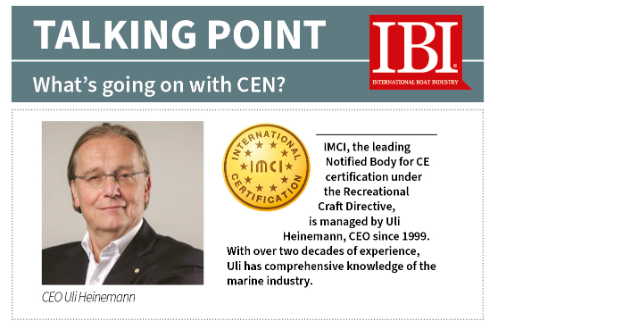TALKING POINT on IBI
What’s going on with CEN?The European Committee for Standardisation, CEN (Comité Européen de Normalisation), is a non-profit organisation whose mission is to promote the European economy in global trade, to ensure the well-being of citizens and to advance environmental protection. CEN is one of three major standardisation organisations in Europe and is responsible for European EN standards in all technical fields except electrical engineering and telecommunications. CENELEC (Comité Européen de Normalisation Électrotechnique) and ETSI (European Telecommunications Standards Institute) are responsible for these areas.
EN standards are also developed from ISO standards. In the so-called harmonisation process of the two, Annex ZA is added to the ISO standard. This turns the ISO standard into an EN ISO standard. Although this process is lengthy, it leads to a clear result, because the annex describes which part of the ISO standard is to be used in order to be able to give the so-called “presumption of conformity” within the framework earnings of an EU directive. If a manufacturer applies an EN ISO standard in the context of his conformity
assessment, he legally protects himself against his customer. Conformity assessment is a process carried out by the manufacturer to prove that certain technical requirements for his product have been fulfilled and thus that compliance with a directive has been achieved.
This construct is also used for the benefit of manufacturers within the framework of the Recreational Craft Directive (RCD).
However, CEN now seems to be going off track and charting a new course.
As an example of the course change, I would like to point out the new annex of EN ISO 25197:2020/A11:2023 “Small craft - Electrical/electronic control systems for steering, shift and throttle”, which may not be shown here for copyright reasons. It now contains a two-part Annex ZA, shown as Table ZA.1 and Table ZA.2. Other standards will follow in the same way.
The content of Table ZA.1 is what market surveillance authorities, manufacturers and we as a notified body are used to. Table ZA.2, however, is new. It is the latter that I am concerned about. Please note the heading of the table “Applicable Standards to confer presumption of conformity as described in this Annex ZA”
In that table I find surprisingly:
- Several non-harmonized ISO standards
- One ASTM standard (from the USA)
- Several non-harmonized IEC standards
- Most of the standards are outside the RCD scope.
My concerns are:
- How can non-harmonized and US standards be used as part of a harmonised EN ISO standard?
- Why do these standards not only remain as normative references in the main body of the standard, as was previously the case, but are now also repeated in Annex ZA.2 for the purpose of demonstrating presumption of conformity?
- Are all the surveillance authorities working under the RCD and all the appointed certifiers really competent enough to assess products against all the listed IEC standards as well as ISO 48921:2016, ISO 48922:2013, ISO 48923:2016, ISO 48924:2013, ISO 167502:2012, ISO 167503:2012 and finally ASTM B117:2016?
- How deep is the testing of a product supposed to go if it already leaves the scope of the RCD?
- How can such a complex testing process be explained in terms of costs?
It seems that the assessment procedure for a small RCD Annex II device covered by EN ISO 25197:2020/A11:2023 will be far more expensive in the future than the assessment of an entire watercraft. Furthermore, this new annex will make a nonsense of the beneficial institution of presumption of conformity and consequently it will be less applied.
This is to the disadvantage of the manufacturers.

